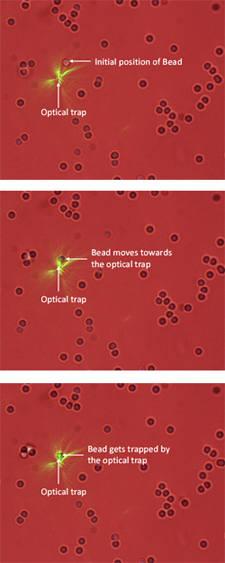 |

|
 |
When an optical trap is placed close to a microparticle, it
pulls the particle towards the focal point. The images above captured using
the imaging device in the optical tweezers system show a microparticle
moving into a trap. |
|
"DETC2012-71236: Using GPUs for Realtime Prediction of Optical Forces on Microsphere Ensembles," a paper by Computer Science graduate student Sujal Bista, Mechanical Engineering graduate student Sagar Chowdhury, Professor S.K. Gupta (ME/ISR), and UMIACS Director Amitabh Varshney (CS/UMIACS), was one of two ?best of conference? papers at the 2012 ASME International Design Engineering Technical Conferences and Computers and Information in Engineering Conference. Chowdhury is advised by Professor Gupta, and Bista is advised by Professor Varshney.
Laser beams can be used to create optical traps that can hold and transport small particles. Optical trapping has been used in a number of applications ranging from prototyping at the microscale to biological cell manipulation. Successfully using optical tweezers requires predicting optical forces on the particle being trapped and transported. The paper introduces a ray-tracing-based application optimized for GPUs to calculate forces exerted by laser beams on microparticle ensembles in an optical tweezers system.
| Read the prize-winning paper |
Related Articles:
Sagar Chowdhury wins ISR graduate student award
Alum Sagar Chowdhury wins ASME CIE Best Dissertation Award
Nacev, Chowdhury place in 2013 Dean's Doctoral Student Research Award competition
S.K. Gupta awarded NSF grant for autonomous optical manipulation of cells
Shneiderman, Varshney inducted into IEEE Visualization Academy
S.K. Gupta leads finalist group in KUKA Innovation competition
Building a smarter industrial robot
Gupta is PI for NSF NRI unmanned surface vehicle grant
S.K. Gupta wins NSF grant for human robot collaboration in manufacturing
Alum Ashis Banerjee joining University of Washington faculty
August 27, 2012
|

